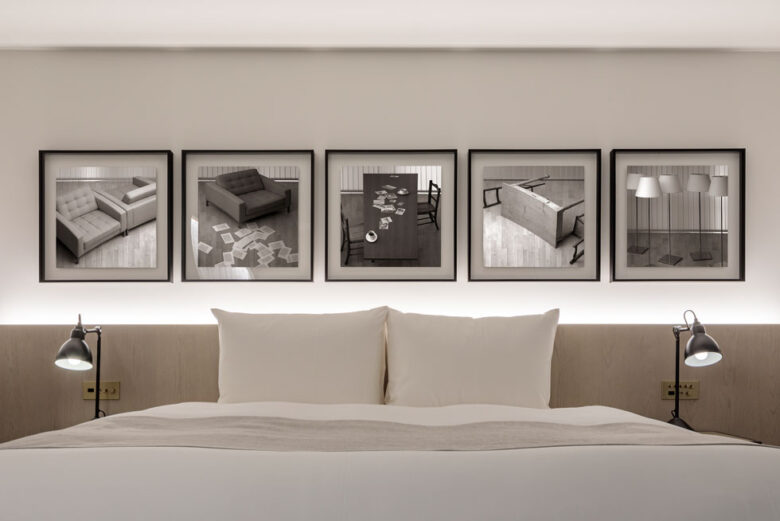ROOM 16 高谷 史郎 / SHIRO TAKATANI


“Topograph / La chambre claire 1–5”
高谷史郎は、1984年からアーティスト・グループ、ダムタイプに、創立メンバーとして参加し、映像、照明、グラフィック・デザイン、舞台装置デザインなどを手がけてきた。ダムタイプとしての活動を続ける一方、1998年からは個人での制作活動を開始し、カメラやプリズムなどの光学装置を用いた映像インスタレーションや、パフォーマンスを発表してきた。写真を制作活動の原点として、先端技術の転用、あるいは原初的な光学装置への回帰などを試みながら、光学現象をいかにアートへと昇華するかについての考察を続けている。舞台そのものをカメラ・ルシダに見立てたパフォーマンス、《明るい部屋》(2008年)を発表するなど、その表現活動は幅広い領域におよび、近年では坂本龍一とのコラボレーションによるパフォーマンス《ST/LL》(2018)など、多彩なジャンルのアーティストとの協働による作品も多く見られる。
通常の写真を撮影する工程では、フィルムの手前をシャッターが降りる一瞬のうちに、レンズを介して得られた光の像がフィルムに焼き付けられていくが、《Topograph》では、ラインスキャナーという、空間をスキャンする工業機材をアート制作に転用し、空間を縦に走査することによって像を取得している。そのため、写真において、レンズであれば奥に行くにつれて生まれるはずの横幅の収縮は発生せず、走査の持つ時間性がより顕著に表れる。同様のスキャニングによる映像作品《Toposcan》では、平面の対象物を線によって写し取る方法で空間をとらえることで、線遠近法にもとづく透視図とは異なる、消失点がなく奥行きのない映像として記述される。《Topograph》、《Toposcan》のいずれも、人間の視覚と、それをもとに空間をとらえた光学装置としてのカメラ、これらとは異なる方法で、空間を認識するものであり、デジタルスキャンという方法によって世界を「見る」という、新たな視覚体験をもたらしている。
Shiro Takatani was a founding member of Dumb Type, an artists’ group formed in 1984. He has worked with videography, lighting, graphic design and stage set design. In 1998, while continuing his activities with Dumb Type, Takatani also began pursuing solo projects in the form of video installations and performances using cameras, prisms, and other optical apparatus. With photography as his starting point, he continues to explore ways of raising optical phenomena to the level of art, both repurposing cutting-edge technologies and returning to the earliest forms of optical equipment in his experiments with technique. He is active in a range of artistic fields, and often collaborates with artists in other genres. His 2008 performance La chambre claire turned a theatre into a camera lucida, and in 2018 he worked with Ryuichi Sakamoto on the collaborative performance ST/LL.
In the usual process of taking a photograph, an image is created on the film by the light that comes through the lens at the moment the shutter drops. In Takatani’s Topograph, images are obtained using a repurposed piece of industrial equipment called a line scanner, which scans the space vertically. The resulting images do not have the perspective distortion seen in photographs taken through lenses, rendering the scanning process’s sense of time more apparent.
In Toposcan, a work of videography created using the same method of scanning the plane line by line, space is captured without depth or vanishing point. This produces an image quite different from projections based on linear perspective. Both Topograph and Toposcan let the viewer “see” the world through a digital scanner that captures space in a manner utterly unlike human eyesight or optical apparatus such as cameras based on how our eyes function, creating an entirely new visual experience.

